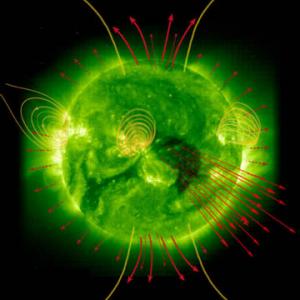Syllabus
(print version in PDF)
Prerequisites:
Classical
Mechanics (PHYS 303), Electromagnetic Theory (PHYS 305),
Analytical Geometry and Calculus (MATH 213), or permission of instructor
Credits: 3
Date:
Thursday
Time:
4:30 PM to 7:10 PM
Place: Research Bldg 1, room
301
Instructors: Prof. Jie Zhang
Contact Info: (703)993-1998
(phone), jzhang7@gmu.edu
(e-mail)
Office
Hour: 3:00
PM to 4:00 PM, Thursday, or by appointment
Office:
Room 351, Research Bldg 1
Description:
This course provides
an advanced understanding of physics processes that govern space
plasma, with a
focus on understanding the structure and dynamics of Sun’s
atmosphere. The
topics include magnetic field (3-D extrapolation, helicity, nullpoint
and
separator), magnetohydrodynamics (MHD), magnetic reconnection, flare
dynamics,
coronal mass ejections, shock and particle acceleration, and solar
wind. After taking this
course, students should (1) have a deep understanding of magnetism and
MHD
physics, (2) understand the physical mechanisms leading to energetic
eruptions,
(3) learn state-of-the-art computational tools to model physical
processes and
compare with observations. This course is intended for
graduate students who are interested in space science and astrophysics.
Content:
- Introduction/Overview:
Solar Physic and Space Weather
- Maxwell
and MHD Equations
- Magnetic
Field 1: potential and force free field, helicity
- Magnetic
field 2: 3-D morphology, null points, separators
- Magnetic
reconnection 1: current sheet
- Magnetic
reconnection 2: Magnetic annihilation
- Magnetic
reconnection 3: Steady reconnection
- Magnetic
reconnection 4: unsteady reconnection
- Solar
application 1: classic models of flares and CMEs
- Solar
application 2: state-of-the-art models of flares and CMEs
- Heliosphere
and solar wind
- Shock
and particle acceleration
- ICMEs and magnetic clouds
Homework: There will be weekly
assignments.
Project: Students
are
required to conduct two research
projects that involves in-depth physics, advanced data analysis,
intensive
computation and literature study. The following two projects
are suggested:
(1) calculating coronal magnetic field using PFSS model, and (2) CME
tracking based
on STEREO observations and 3-D magnetic field configuration
Exams: one midterm and one
comprehensive final exam
Grades: Homework
(25%), Projects (25%),
Midterm (25%), Final Exam (25%)
Class
URL:
http://solar.gmu.edu/teaching/2010_CSI769/
Text
Book (required):
- “Magnetic
Reconnection – MHD Theory and Applications”, Eric
Priest and Terry Forbes, Cambridge University Press, ISBN
0-521-03394-2, 2000
Supplement
Reference Books:
- “Physics
of the Solar Corona”, Markus J. Aschwanden, Praxis
Publishing, ISBN 3-540-30765-6, 2006
- “An
Introduction to Plasmas and Particles in the Heliosphere and
Magnetospheres”, May-Britt Kallenrode, 2004
- "Plasma
Physics for Astrophysics", Russell M. Kulsrud, Princeton University
Press, ISBN 0-691-12073-0, 2005
- Online
resources
Computational
Tools:
